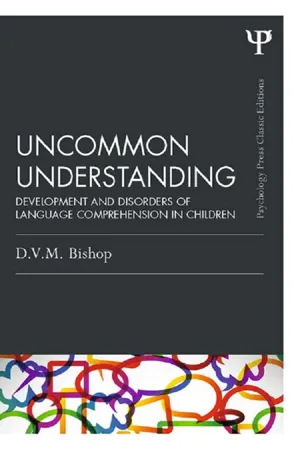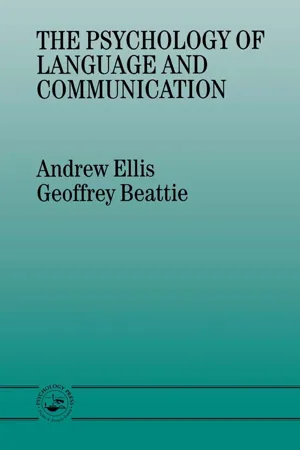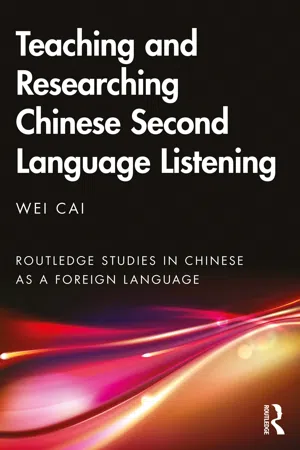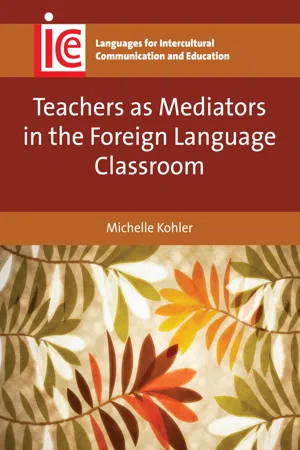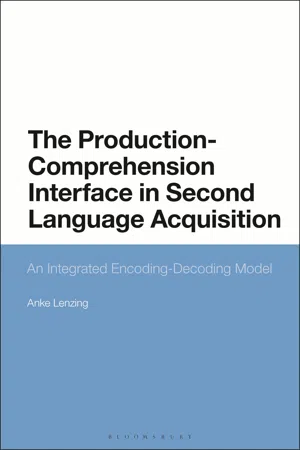Languages & Linguistics
Language Comprehension
Language comprehension refers to the ability to understand and interpret spoken or written language. It involves processing linguistic input, extracting meaning, and making sense of the information conveyed. This cognitive process encompasses various skills such as vocabulary knowledge, grammar understanding, and the ability to infer meaning from context.
Written by Perlego with AI-assistance
Related key terms
6 Key excerpts on "Language Comprehension"
- eBook - ePub
Uncommon Understanding (Classic Edition)
Development and disorders of language comprehension in children
- Dorothy V. M. Bishop(Author)
- 2014(Publication Date)
- Psychology Press(Publisher)
1FROM SOUND TO MEANING
A FRAMEWORK FOR ANALYSING COMPREHENSIONLanguage is so readily acquired and so universal in human affairs that it is easy to forget what a complex phenomenon it is. Despite years of research, we still understand remarkably little about how language works. Consider the problems there have been in developing computers that can process human language. What an advantage it would be to have an automatic system that could listen to a person talking and translate their speech into a written form—a combined Dictaphone and word processor that did all the work of an audio-typist. Technology is now advancing to the stage where this kind of machine is possible, but it has taken more than 30 years of intensive research to achieve this goal, and the best contemporary speech recognition devices are less good than a four-year-old child at recognising a stream of continuous speech spoken by an unfamiliar speaker. Suppose, though, we try to crack a different problem: rather than getting a machine to recognise spoken words, let us present it with ready-typed sentences, and see if it can decode meaning well enough to translate from one language to another. Here too, enormous effort has been expended in trying to achieve a solution, yet the results so far are unimpressive (see Machine translation , overleaf). One thing that makes Language Comprehension such an intriguing topic is that it is something that computers are relatively bad at, despite their enormous power and speed of operation. Against this background, it is all the more remarkable that nearly all children soak up language in the first few years of life, apparently requiring only a modest amount of linguistic stimulation in order to develop, by the age of four years or so, into language users who are far more competent than the most sophisticated computer.This chapter will set the scene for the rest of the book by giving a preliminary overview of the different stages involved in comprehension. In Chapter 2 - eBook - ePub
- Geoffrey Beattie, Andrew Ellis(Authors)
- 2014(Publication Date)
- Psychology Press(Publisher)
13 Language Comprehensionand memoryWe began this book by defining communication in Chapter 1 as the encoding of a message by one organism into a physical signal which passes to another organism who decodes the signal in order to recreate the original message. We have since noted how human beings employ not one but several channels of communication or ‘signal systems’, such as facial expressions, gestures, eye contact, speech etc. Chapter 7 was concerned with the encoding of a message into just one of those channels, namely speech. We saw then how speech planning involves linguistic units of different sizes, ranging from admittedly rather ill-defined ‘idea units’, through sentences, clauses, words and morphemes, to phonemes or letters. Evidence from slips of the tongue, pauses and other sources suggested that all of these units have ‘psychological reality’ as far as speech production is concerned.In the previous chapter we looked at the parts played by phonemes, letters, morphemes and words in language reception (listening and reading). It should not surprise us that these units of planning also turned out to have a role in perception: that which is a unit of encoding is also likely to be a unit of decoding. In this chapter we turn to a consideration of the processes involved in comprehending clauses, sentences, and text.Throughout this book we have tried to emphasize that the natural use of language, for which our cognitive processes are most likely to be adapted, is conversational give-and-take. Sadly, very little research has been done on either the production or comprehension of speech in conversational settings. In a typical Language Comprehension experiment a ‘subject’ (volunteer) sits in silence reading a passage of text, or listening to one through headphones. The subject's task might be to press a button when a specified target word occurs, or to recall parts of the text later (note our comment in Chapter 1 that communication only requires the decoder to have a potential - Wei Cai(Author)
- 2022(Publication Date)
- Routledge(Publisher)
This chapter presents major theories that have had large impacts on both general and Chinese L2 listening. These theories provide descriptions of how listeners process sound signals and establish meaning in aural texts, and how the various processes and knowledge sources work to reach the goal of comprehension. Bottom-up, top-down, and interactive theories have served as important conceptual frameworks for empirical studies on listening and have deeply influenced listening pedagogy. As discussed earlier, listening is the least understood skill among the four language skills. This includes our theoretical understanding of the listening process. Some of the specific Language Comprehension models reviewed above have not been adequately applied to listening. We still need to explore L2 listening comprehension theories that can give us more thorough explanations of the listening process and are supported by empirical evidence.Passage contains an image
2 Core issues in L2 listening
DOI: 10.4324/9780429060007-4Knowledge
As discussed in Chapter 1 , the goal of listening comprehension is to establish a coherent mental representation of what is heard, which requires that learners possess sufficient linguistic and non-linguistic knowledge. Linguistic knowledge includes phonetic, phonological, lexical, syntactic, semantic, and discourse knowledge, whereas non-linguistic knowledge involves general world knowledge organized in schemata. It is widely acknowledged that linguistic and non-linguistic knowledge is used interactively, mutually informing and supporting each other though they may perform different roles. During the comprehension process, speech signals trigger our linguistic knowledge to decode sounds, create meanings, and activate relevant schemata to fill in information gaps and enrich comprehension. Empirical studies show that learners draw upon a wide range of knowledge sources, both linguistic and non-linguistic knowledge, to arrive at the meaning of the spoken text they hear (Wu, 1998 ; Lee & Cai, 2010 ).Field (2008b- Michelle Kohler(Author)
- 2015(Publication Date)
- Multilingual Matters(Publisher)
Language is arguably the most fundamental concept within the field of language teaching and learning. Understandings of language vary, however, typically falling into two main categories: language as code or language as social semiotic.Language as codeLanguage can be understood as a code or system for labelling the world. In this view, the code is comprised of forms: lexical and syntactical. The code is governed by rules, which are fixed and enable mastery of the code in set ways. Language exists as an entity in its own right and is largely detached from its users. This view of language is particularly associated with the field of second language acquisition. It is a view influenced by the work of Chomsky (1965) whose theory of generative grammar proposed the idea that the human brain was hardwired for language and its development was largely automatic or predetermined. Humans, therefore, have an innate capacity for language. When this position is adopted in language teaching, language development is regarded as a cognitive process first and foremost. Cognitive models of language development rely heavily on computational metaphors of acquisition involving input and output processes. Krashen (1982) argued a distinction between language acquisition and learning with the former preferred over the latter in terms of effective language development. Krashen’s notion of ‘comprehensible input’ related to the idea that the unconscious process of acquiring language required a rich language environment in which the language learner would select what was necessary for the next stage of development. While this model was devised for ‘natural’ language acquisition and did not specifically relate to second language learning in a formal learning context, it created interest in ‘input’ in approaches to language teaching. There was an emphasis on the language teacher using native-speaker-like talk to simulate the acquisition process. Work since has also focused on ‘output’ (Swain, 1985) in an effort to acknowledge the benefits of learners’ productive capacities and associated metalinguistic awareness to their language development. Following such work, knowing a language meant more than knowing how to use a language, it also meant knowing- eBook - ePub
Teaching Foreign Language Skills
Second Edition
- Wilga M. Rivers(Author)
- 2018(Publication Date)
- University of Chicago Press(Publisher)
6 Listening ComprehensionSpeaking does not of itself constitute communication unless what is being said is comprehended by another person. The greatest difficulty for travelers in strange countries is not primarily that they cannot make themselves understood; this they can frequently do by gesture, by writing, or by pointing to something written in a bilingual book of phrases. Their major difficulty, and one that leads to considerable emotional embarrassment, is that they cannot understand what is being said to them and around them. Even if the native speaker enunciates the words slowly and distinctly, elements of stress, intonation, and word grouping (often exaggerated in an earnest attempt at clarity) add to the confusion of the inexperienced foreigner. As a result, there is no communication, and the traveler’s speaking skills cannot be exercised to great advantage. Enjoyment of and participation in community life and thought are further curtailed by inability to comprehend announcements, broadcasts, lectures, plays, and films.Teaching the comprehension of spoken language is of primary importance if the communication aim is to be achieved. A frequently neglected area, listening comprehension has its peculiar problems which arise from the fleeting, immaterial nature of spoken utterances and the complicated ways we process what we hear.THEORETICAL CONCEPTS BASIC TO LISTENING COMPREHENSIONIn chapter 5 , the special problems of discrimination of sounds, stress, and intonation are discussed, but these are only a few of the elements involved in understanding what is being said to us.Information TheoryUseful ideas for teaching listening comprehension can be drawn from the research of communications engineers concerned with the maximum efficiency of telephonic and telegraphic equipment. Their work has dealt particularly with the nature of the message to be communicated, the qualities of the channel by which it passes from emitter to receiver, and the state in which it is received and interpreted by the listener.1 We are not concerned here with detailed mathematical explanations of information theory, which had a profound influence on psychological research in the sixties, but rather the lines of thought that can be extracted from it for the teacher. (Information theory should not be confused with information processing, which is the term used for the activity of the mind in extracting, processing, storing, and retrieving the meaning of verbal and nonverbal material. This concept, which is basic to much contemporary research in perception, artificial intelligence, and cognition, is discussed later in this chapter.)2 - eBook - ePub
The Production-Comprehension Interface in Second Language Acquisition
An Integrated Encoding-Decoding Model
- Anke Lenzing(Author)
- 2021(Publication Date)
- Bloomsbury Academic(Publisher)
2 The relation between production and comprehension in language processingAs discussed in the Introduction and Chapter 1 , in recent decades, much research has been devoted to some of the core issues related to language production and comprehension processes, and the results of numerous studies provide many insights into how humans produce and understand language.This chapter engages with the relation between production and comprehension in human language processing. As the overall goal of this book is to model interfaces between production and comprehension in SLA, the relation between the two modalities in human language processing is considered to be of crucial importance. According to Kempen (1999: v),[a] fundamental question regarding the cognitive architecture of human syntactic processing concerns the relationship between its two main modalities: grammatical encoding (formulating) and grammatical decoding (parsing). Are they subserved by different types of syntactic processor (i.e. modules operating on very different principles), or is the same type [of] processing module, a grammatical coder, deployed in both parsing and formulating? In the latter case, our cognitive system may contain two exemplars of this module (one for parsing, one for formulating), or one exemplar could subserve both modalities, presumably in time-sharing mode. (italics original)Traditionally, the mechanisms of production and comprehension have largely been studied separately, as the standard assumption in linguistics and cognitive psychology is that these processes occur in two different modules with two different types of operations (see e.g. the discussion in Gambi & Pickering 2017; Kempen, Olsthoorn & Sprenger 2012: 347–8; Meyer, Huettig & Levelt 2016; Pickering & Garrod 2007: 105–6). Proponents of the view that there are two separate systems involved in production and comprehension include for instance Clark and Malt (1984), Chapman and Miller (1975) and Ruder and Finch (1987). However, this view has recently been challenged by proponents of a more integrated view of syntactic processes in production and comprehension (e.g. Garrett 2000; Kempen, Olsthoorn & Sprenger 2012; Pickering & Garrod 2004, 2007, 2013; Segaert et al. 2012).
Index pages curate the most relevant extracts from our library of academic textbooks. They’ve been created using an in-house natural language model (NLM), each adding context and meaning to key research topics.
